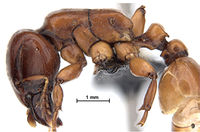Metapone nivanuatu
| Metapone nivanuatu | |
|---|---|

| |
| Scientific classification | |
| Kingdom: | Animalia |
| Phylum: | Arthropoda |
| Class: | Insecta |
| Order: | Hymenoptera |
| Family: | Formicidae |
| Subfamily: | Myrmicinae |
| Tribe: | Crematogastrini |
| Genus: | Metapone |
| Species: | M. nivanuatu |
| Binomial name | |
| Metapone nivanuatu Taylor, 2018 | |
Known only from the holotype worker collected from a rotten log in swamp forest with sago and Hibiscus tiliaceus. The collection occurred as part of a the "Royal Society New Hebrides Expedition, NH 64". The collector, Lee, targeted termites during the Royal Society expedition so the type was probably collected associated with termites (Taylor 2018).
Identification
Taylor (2018) - Metapone nivanuatu most closely resembles the unique holotype of the divergent Papua New Guinean species Metapone philwardi.
Because of its colour, reduced subpetiolar structure and large size this distinctive species fails the 2016 Taylor & Alpert key to the Micronesian, Melanesian and Pacific species of Metapone, and the key discriminating the Australian taxa. None of the Australian Metapone species are even remotely similar to Metapone nivanuatu.
Distribution
Latitudinal Distribution Pattern
Latitudinal Range: -16.516667° to -16.516667°.
| North Temperate |
North Subtropical |
Tropical | South Subtropical |
South Temperate |
- Source: AntMaps
Distribution based on Regional Taxon Lists
Indo-Australian Region: Vanuatu (type locality).
Distribution based on AntMaps
Distribution based on AntWeb specimens
Check data from AntWeb
Countries Occupied
| Number of countries occupied by this species based on AntWiki Regional Taxon Lists. In general, fewer countries occupied indicates a narrower range, while more countries indicates a more widespread species. |

|
Estimated Abundance
| Relative abundance based on number of AntMaps records per species (this species within the purple bar). Fewer records (to the left) indicates a less abundant/encountered species while more records (to the right) indicates more abundant/encountered species. |

|
Biology
Termite associates: Gross (1975: 392, tabs. 1 & 2) reported 12 Vanuatuan termite species (five of them endemic) in seven genera. At least five species in three families (Termitidae, Kalotermitidae, Rhinotermitidae) were listed from Malekula Island (ibid., tab. 9). No scientific names were given for the species or genera. Any one of them could provide a host for Metapone nivanuatu sp.n. (see Taylor & Alpert 2016: 502).
Castes
Nomenclature
The following information is derived from Barry Bolton's Online Catalogue of the Ants of the World.
- nivanuatu. Metapone nivanuatu Taylor, 2018: 100, figs. 6-11 (w.) VANUATU (Malekula I.).
- Type-material: holotype worker.
- Type-locality: Vanuatu: Malekula I., South West Bay, 16°31’S, 167°27’E, 9.x.1971, Royal Society New Hebrides Expd., NH 64 (K.E. Lee).
- Type-depository: ANIC.
- Distribution: Vanuatu.
Unless otherwise noted the text for the remainder of this section is reported from the publication that includes the original description.
Description
Worker
General features as in the accompanying figures. Substantially larger than the Metapone philwardi holotype (compare measurements and indices above with those below: the standard dimensions TL, HW, MSL, and GW are all 1.4 to 1.5 times greater than those of philwardi). Anterior border of clypeal rostrum very slightly concave and squarely transverse; lateral borders moderately deeply concave, so that the anterolateral corners of the sclerite are sub-nodulate. Petiolar dorsum relatively broad compared to Metapone philwardi, with larger, more pronounced posterodorsal extensions. Sculpturing overall less intense than in philwardi: Mandibles smooth and shining. Clypeal rostrum smooth and shining (versus finely, densely longitudinally striate, except along the immediate anterior border in philwardi). Longitudinal striae of frons more coarse, less abundant and less regular than in Metapone philwardi. Promesonotum with a few somewhat effaced vestigial medial striae, otherwise unsculptured (versus finely and entirely longitudinally striate). Sides of mesosoma longitudinally and largely diagonally striate (inclined forwards); propodeal declivity, petiole, postpetiole and gaster smooth and shining (as in Metapone philwardi). Subpetiolar extension small, subtriangular, slightly hooked posteriorly; basally shorter and less-extended than in Metapone philwardi. Colour pale brown, somewhat similar to Metapone philwardi but less brightly golden. The pilosity of the holotype is largely abraded and damaged, so comparison with Metapone philwardi is not possible. Dimensions (mm): TL: ca 10.6; HL: 2.39; HW: 1.95; CI: 62; CpL: 1.00; CpI: 42; MSL: 2.71; PML: 1.38; PMW: 1.33; PMI: 51; PDW: 1.05; PetL: 0.68; PetW: 0.92; PetH: 0.84; PpetL: 0.68; PpetW: 0.90; PpetH: 0.84; GW: 1.98.
Type Material
Vanuatu: Malekula Island: South West Bay, 16° 31' S, 167° 27' E. Australian National Insect Collection (Type No. 32-069954). ex rotten log, swamp forest with sago and Hibiscus tiliaceus , K. E. Lee, 9.X.1971, Royal Society New Hebrides Expedition, NH 64.
The type data are from two labels prepared after collection. The main tag was printed on inappropriate paper, the (coated?) surface of which released many white fragments into the storage ethanol. Some particles still adhere to the mounted Metapone nivanuatu holotype.
Etymology
The name is a noun in apposition acknowledging the indigenous Nivanuatuan people.

